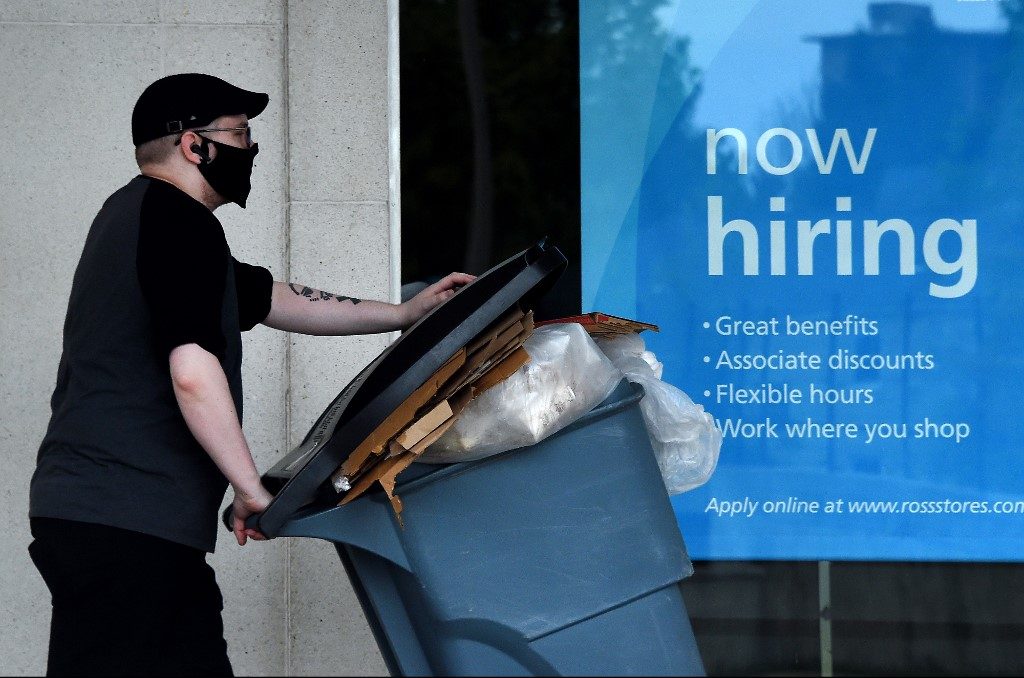SUMMARY
This is AI generated summarization, which may have errors. For context, always refer to the full article.

WASHINGTON, USA – The United States economy regained 2.5 million jobs in May and the unemployment rate dropped as coronavirus pandemic shutdowns began to ease, which President Donald Trump said Friday, June 5, was a sign the recovery from the crisis is underway.
New Labor Department data showed the largest increase in jobs on record, which pushed the unemployment rate down to 13.3% from 14.7% in April.
The Friday report defied even the most optimistic expectations among economists, who had been expecting employment losses of more than 8 million and a jobless rate of 20% or higher.
Trump immediately cheered the data and said the gains proved the combination of rapid government support and a push to reopen businesses was working.
“Today is probably the greatest comeback in American history, but it’s not going to stop here,” Trump told reporters at the White House, saying the recovery will continue unless “the wrong people get in here,” an apparent reference to the November presidential election.
Likening the pandemic to a hurricane, Trump, who is counting on a solid economy to convince voters he deserves a second term, has never wavered from his confidence in a sharp, “V-shaped” rebound.
“This is better than a ‘V,’ it’s a rocket ship!”
3 points higher
The jobs report attributed the improvements to “a limited resumption of economic activity that had been curtailed in March and April due to the coronavirus (COVID-19) pandemic and efforts to contain it.”
However, as it has for the past two months, the Labor Department said the jobless rate was likely 3 points higher due to errors in how workers described their employment status.
A separate report with state data on weekly initial claims for unemployment benefits shows that over 42 million people have lost their jobs, at least temporarily, since mid-March when the shutdowns to contain the spread of COVID-19 began.
But with a massive $3-trillion infusion of government aid, and trillions more in lending to businesses, economists say it is likely firms were able to bring workers back.
Trump promised to push for a payroll tax cut as well as additional stimulus to ensure the recovery continues, at the same time as he signed into law a measure that extends the Paycheck Protection Program (PPP) to 24 weeks from 8.
The reform of the popular small business program lowers the loan amount that must be used for payroll, and extends the loan terms to 5 years from the original 2 – changes businesses had been calling for.
Ian Shepherdson of Pantheon Macroeconomics, one of few who anticipated positive news in the jobs data, called the report, “The biggest payroll surprise in history, by a gigantic margin,” which he said “likely is due to a wave of hidden rehiring.”
With states allowing businesses to reopen, employment last month rose sharply in leisure and hospitality, construction, retail trade, and education and health services, according to the data.
And the number of workers on temporary layoff declined by 2.7 million to 15.3 million, in a sign people have been able to return to their jobs.
The gains came despite downward revisions to March and April that subtracted another 690,000 jobs and another sharp decline in government employment, which dropped by 585,000 positions.
Temporary or permanent?
Some economists warned it may be too soon to get confident about the recovery since employers may not be able to keep those employees.
Harvard economist Jason Furman notes the reduction in temporary layoffs was “the easy part of the recovery,” and further job gains may come more slowly.
Diane Swonk of Grant Thornton said it remains to be seen whether the firms rehiring now can keep workers on payroll.
“There are still 15.3 million workers on temporary layoffs. Research by the University of Chicago suggests that more than 40% of those temporary layoffs in April will become permanent in the months to come,” she said.
The data also reflect the time before the killing of George Floyd at the hands of police sparked nationwide protests over racial injustice, along with looting in some cities. – Rappler.com
Add a comment
How does this make you feel?
There are no comments yet. Add your comment to start the conversation.